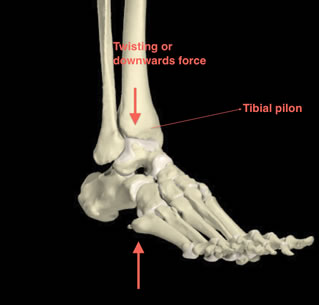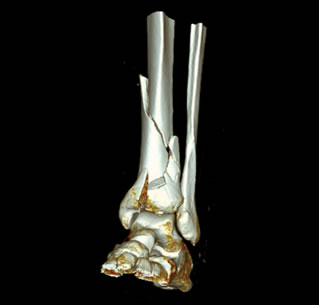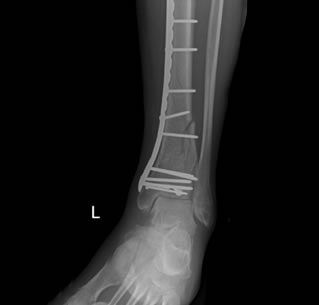in Foot and Ankle Surgery and Reconstruction
Pilon refers to the actions of a pestle crushing into a mortar. In the ankle, if you land heavily on your ankle the bones in the ankle can impact forcefully together and the tibial bone or shin bone can break near the ankle. Hence injury is so-called because of the way it usually happens.

Often from a severe upwards directed force through your ankle such as in a fall from a height. It can also happen during a significant twist of your lower leg for example in fall during skiing or a more severe injury such as a road traffic collision.
Pain is immediate and severe. The ankle swells up rapidly and can deform. It is not possible to walk. It is a significant injury.
Seek immediate help via the emergency services or a local hospital. The most effective way to treat the immediate symptoms of pain and swelling is to rapidly splint the limb and take effective pain-killers. These are best administered by suitably qualified medical personnel. Once you are in hospital then a plaster cast splint can be applied which will give you enormous pain relief.
An X-Ray of the ankle is imperative. The Orthopaedic foot and ankle surgeon will get a more detailed CT (computerised tomography) scan, which can give a 3D view of your ankle and help plan the treatment.

The vast majority of injuries are treated with an operation to insert screws and plates to stabilise the break. Sometimes the surgeon may advocate an external fixation device such as an Ilizarov frame or Taylor Spatial frame, if plates and screws on the inside were deemed unsuitable but not many surgeons can perform this procedure, however Mr Roche does perform this surgery when necessary. Rarely, less severe pilon fractures can be treated non-operatively in a plaster cast.


Normal healing of a fracture to the tibia can take at least 6 months. It does depend on a number of factors for example if you break your tibia or shin bone in the middle of the bone it can take longer than if you break the tibia closer to the ankle. Return to normal full activities can take 9-12 months.
Over 80% will initially heal with no significant complications in the early stages following the injury. You can help the healing process by simple measures such as avoiding smoking and not taking anti-inflammatory medicines because there is some medical evidence to suggest they can delay healing of the fracture. After it has healed you will always “remember” you have broken your tibia as you may experience intermittent symptoms such as mild stiffness or swelling in your ankle. In around 35% of cases the fracture unfortunately can lead to irreversible wear and tear (arthritis) in the joint irrespective of the type of treatment received. This can be treated in the future if problematic.